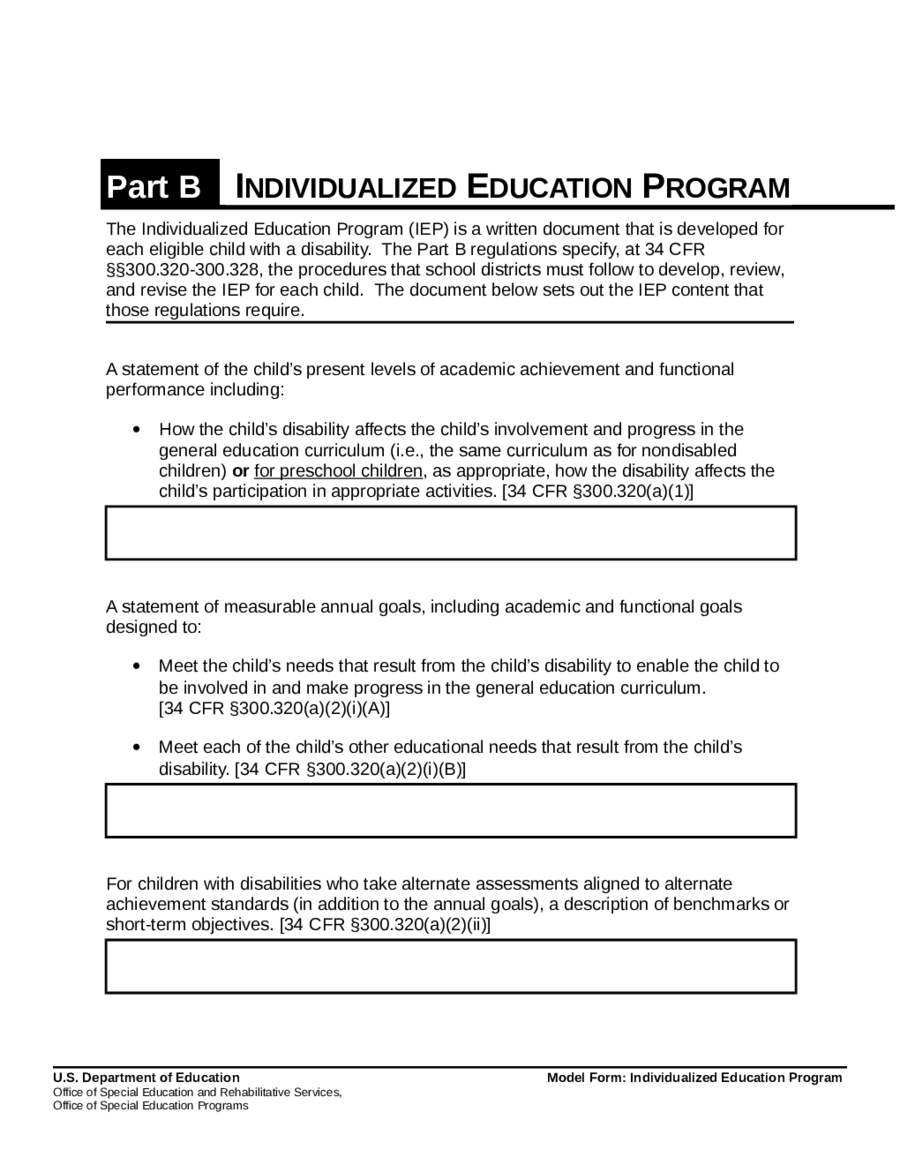Fillable Printable IDEA 2004 Model Form: Part B Individualized Education Program (MS Word)
Fillable Printable IDEA 2004 Model Form: Part B Individualized Education Program (MS Word)

IDEA 2004 Model Form: Part B Individualized Education Program (MS Word)

Part B
INDIVIDUALIZED EDUCATION PROGRAM
The Individualized Education Program (IEP) is a written document that is developed for
each eligible child with a disability. The Part B regulations specify, at 34 CFR
§§300.320-300.328, the procedures that school districts must follow to develop, review,
and revise the IEP for each child. The document below sets out the IEP content that
those regulations require.
A statement of the child’s present levels of academic achievement and functional
performance including:
How the child’s disability affects the child’s involvement and progress in the
general education curriculum (i.e., the same curriculum as for nondisabled
children) or for preschool children, as appropriate, how the disability affects the
child’s participation in appropriate activities. [34 CFR §300.320(a)(1)]
A statement of measurable annual goals, including academic and functional goals
designed to:
Meet the child’s needs that result from the child’s disability to enable the child to
be involved in and make progress in the general education curriculum.
[34 CFR §300.320(a)(2)(i)(A)]
Meet each of the child’s other educational needs that result from the child’s
disability. [34 CFR §300.320(a)(2)(i)(B)]
For children with disabilities who take alternate assessments aligned to alternate
achievement standards (in addition to the annual goals), a description of benchmarks or
short-term objectives. [34 CFR §300.320(a)(2)(ii)]
U.S. Department of Education Model Form: Individualized Education Program
Office of Special Education and Rehabilitative Services,
Office of Special Education Programs

Part B INDIVIDUALIZED EDUCATION PROGRAM 2
A description of:
How the child’s progress toward meeting the annual goals will be measured.
[34 CFR §300.320(a)(3)(i)]
When periodic reports on the progress the child is making toward meeting the
annual goals will be provided such as through the use of quarterly or other
periodic reports, concurrent with the issuance of report cards.
[34 CFR §300.320(a)(3)(ii)]
A statement of the special education and related services and supplementary aids and
services, based on peer-reviewed research to the extent practicable, to be provided to
the child, or on behalf of the child, and a statement of the program modifications or
supports for school personnel that will be provided to enable the child:
To advance appropriately toward attaining the annual goals.
[34 CFR §300.320(a)(4)(i)]
To be involved in and make progress in the general education curriculum and to
participate in extracurricular and other nonacademic activities.
[34 CFR §300.320(a)(4)(ii)]
To be educated and participate with other children with disabilities and
nondisabled children in extracurricular and other nonacademic activities.
[34 CFR §300.320(a)(4)(iii)]
An explanation of the extent, if any, to which the child will not participate with
nondisabled children in the regular classroom and in extracurricular and other
nonacademic activities. [34 CFR §300.320(a)(5)]

Part B INDIVIDUALIZED EDUCATION PROGRAM 3
A statement of any individual appropriate accommodations that are necessary to
measure the academic achievement and functional performance of the child on State
and districtwide assessments. [34 CFR §300.320(a)(6)(i)]
If the IEP Team determines that the child must take an alternate assessment instead of
a particular regular State or districtwide assessment of student achievement, a
statement of why:
The child cannot participate in the regular assessment. [34 CFR §300.320(a)(6)
(ii)(A)]
The particular alternate assessment selected is appropriate for the child.
[34 CFR §300.320(a)(6)(ii)(B)]
The projected date for the beginning of the services and modifications and the
anticipated frequency, location, and duration of special education and related services
and supplementary aids and services and modifications and supports.
[34 CFR §300.320(a)(7)]
Service, Aid or
Modification Frequency Location
Beginning
Date Duration

Part B INDIVIDUALIZED EDUCATION PROGRAM 4
TRANSITION SERVICES
Beginning not later than the first IEP to be in effect when the child turns 16, or younger if
determined appropriate by the IEP Team, and updated annually thereafter, the IEP must
include:
Appropriate measurable postsecondary goals based upon age-appropriate
transition assessments related to training, education, employment, and where
appropriate, independent living skills. [34 CFR §300.320(b)(1)]
The transition services (including courses of study) needed to assist the child in
reaching those goals. [34 CFR §300.320(b)(2)]
Transition Services (Including Courses of Study)
RIGHTS THAT TRANSFER AT AGE OF MAJORITY
Beginning not later than one year before the child reaches the age of majority
under State law, the IEP must include a statement that the child has been
informed of the child’s rights under Part B of the IDEA, if any, that will, consistent
with 34 CFR §300.520, transfer to the child on reaching the age of majority.
[34 CFR §300.320(c)]



